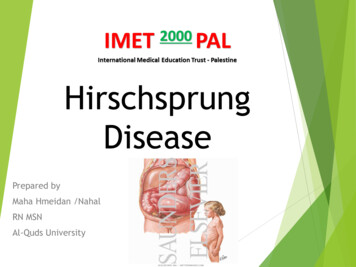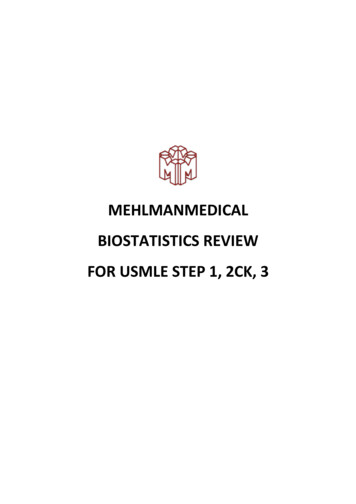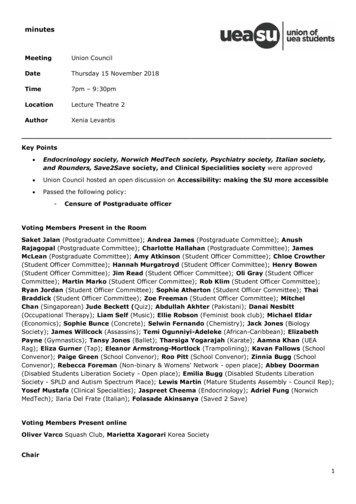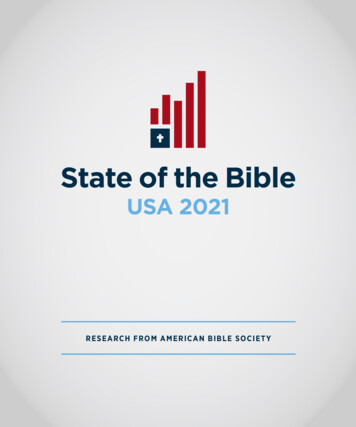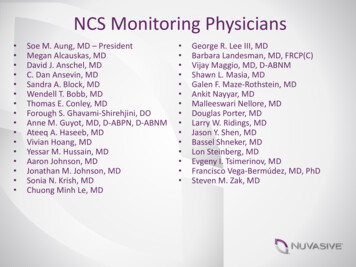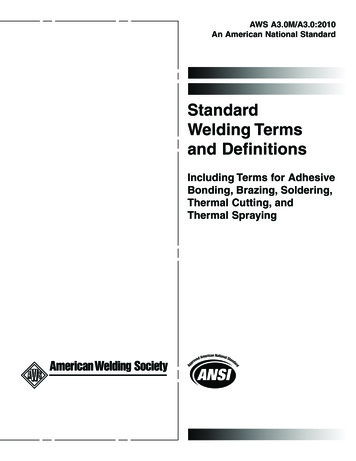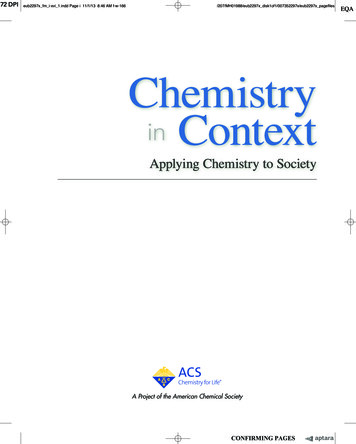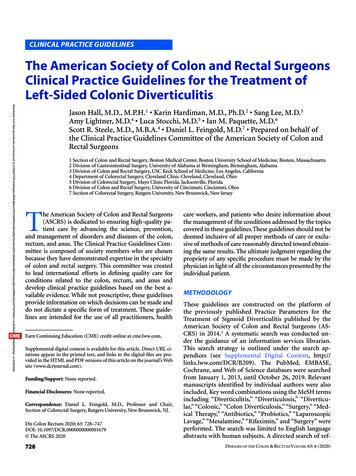
Transcription
CLINICAL PRACTICE GUIDELINESThe American Society of Colon and Rectal SurgeonsClinical Practice Guidelines for the Treatment ofLeft-Sided Colonic DiverticulitisDownloaded from https://journals.lww.com/dcrjournal by ySnFF8XYif3Wu1 aLfG/RwOoqepMVfjbRG/tpOg on 05/30/2020Jason Hall, M.D., M.P.H.1 Karin Hardiman, M.D., Ph.D.2 Sang Lee, M.D.3Amy Lightner, M.D.4 Luca Stocchi, M.D.5 Ian M. Paquette, M.D.6Scott R. Steele, M.D., M.B.A.4 Daniel L. Feingold, M.D.7 Prepared on behalf ofthe Clinical Practice Guidelines Committee of the American Society of Colon andRectal Surgeons1 Section of Colon and Rectal Surgery, Boston Medical Center, Boston University School of Medicine, Boston, Massachusetts2 Division of Gastrointestinal Surgery, University of Alabama at Birmingham, Birmingham, Alabama3 Division of Colon and Rectal Surgery, USC Keck School of Medicine, Los Angeles, California4 Department of Colorectal Surgery, Cleveland Clinic Cleveland, Cleveland, Ohio5 Division of Colorectal Surgery, Mayo Clinic Florida, Jacksonville, Florida6 Division of Colon and Rectal Surgery, University of Cincinnati, Cincinnati, Ohio7 Section of Colorectal Surgery, Rutgers University, New Brunswick, New JerseyThe American Society of Colon and Rectal Surgeons(ASCRS) is dedicated to ensuring high-quality patient care by advancing the science, prevention,and management of disorders and diseases of the colon,rectum, and anus. The Clinical Practice Guidelines Committee is composed of society members who are chosenbecause they have demonstrated expertise in the specialtyof colon and rectal surgery. This committee was createdto lead international efforts in defining quality care forconditions related to the colon, rectum, and anus anddevelop clinical practice guidelines based on the best available evidence. While not proscriptive, these guidelinesprovide information on which decisions can be made anddo not dictate a specific form of treatment. These guidelines are intended for the use of all practitioners, healthEarn Continuing Education (CME) credit online at cme.lww.com.Supplemental digital content is available for this article. Direct URL citations appear in the printed text, and links to the digital files are provided in the HTML and PDF versions of this article on the journal’s Website (www.dcrjournal.com).Funding/Support: None reported.Financial Disclosures: None reported.Correspondence: Daniel L. Feingold, M.D., Professor and Chair,Section of Colorectal Surgery, Rutgers University, New Brunswick, NJ.Dis Colon Rectum 2020; 63: 728–747DOI: 10.1097/DCR.0000000000001679 The ASCRS 2020728care workers, and patients who desire information aboutthe management of the conditions addressed by the topicscovered in these guidelines.These guidelines should not bedeemed inclusive of all proper methods of care or exclusive of methods of care reasonably directed toward obtaining the same results. The ultimate judgment regarding thepropriety of any specific procedure must be made by thephysician in light of all the circumstances presented by theindividual patient.METHODOLOGYThese guidelines are constructed on the platform ofthe previously published Practice Parameters for theTreatment of Sigmoid Diverticulitis published by theAmerican Society of Colon and Rectal Surgeons (ASCRS) in 2014.1 A systematic search was conducted under the guidance of an information services librarian.This search strategy is outlined under the search appendices (see Supplemental Digital Content, http://links.lww.com/DCR/B209). The PubMed, EMBASE,Cochrane, and Web of Science databases were searchedfrom January 1, 2013, until October 26, 2019. Relevantmanuscripts identified by individual authors were alsoincluded. Key word combinations using the MeSH termsincluding “Diverticulitis,” “Diverticulosis,” “Diverticular,” “Colonic,” “Colon Diverticulosis,” “Surgery,” “Medical Therapy,” “Antibiotics,” “Probiotics,” “LaparoscopicLavage,” “Mesalamine,” “Rifaximin,” and “Surgery” wereperformed. The search was limited to English languageabstracts with human subjects. A directed search of refDISEASES OF THE COLON & RECTUM VOLUME 63: 6 (2020)
729DISEASES OF THE COLON & RECTUM VOLUME 63: 6 (2020)erences embedded in the candidate publications wasalso performed. Emphasis was placed on prospectivetrials, meta-analyses, systematic reviews, and practiceguidelines. Peer-reviewed observational studies and retrospective studies were included when higher-qualityevidence was insufficient. In brief, a total of 4885 uniquejournal titles were identified. Initial review of the searchresults led to the exclusion of 4223 titles based on irrelevance of the title or because they consisted of a casereport, letter to the editor, or nonsystematic review. Areview of the remaining 662 titles included assessmentof the full-length articles. This led to exclusion of anadditional 494 titles for which similar but higher-levelevidence was available. The remaining 168 titles wereconsidered for grading of the recommendations (Fig. 1).The final source material used was evaluated for themethodological quality, the evidence base was examined, and a treatment guideline was formulated by thesubcommittee for this guideline. The final grade of recommendation and level of evidence for each statementwere determined using the Grades of Recommendation,Assessment, Development, and Evaluation system (Table 1).2 When agreement was incomplete regarding theevidence base or treatment guideline, consensus fromthe committee chair, vice chair, and 2 assigned reviewers determined the outcome. Members of the ASCRSClinical Practice Guidelines Committee worked in jointproduction of these guidelines from inception to publication. Recommendations formulated by the subcommittee were reviewed by the entire Clinical PracticeGuidelines Committee. The submission was peer-reviewed by Diseases of the Colon & Rectum and the finalrecommendations were approved by the ASCRS Executive Council. In general, each ASCRS Clinical PracticeGuideline is updated every 5 years. No funding was received for preparing this guideline and the authors havedeclared no competing interests related to this material.The terms uncomplicated and complicated diverticulitis, symptomatic uncomplicated diverticular disease(SUDD), and recurrent diverticulitis are used throughout this document. For purposes of this guideline,complicated diverticulitis is defined as diverticulitis associated with uncontained, free perforation with a systemic inflammatory response, fistula, abscess, stricture,or obstruction. Micro-perforation with small amountsof contained, extraluminal gas, in the absence of a systemic inflammatory response, is not considered complicated diverticulitis. Uncomplicated diverticulitis isdefined as diverticulitis that is not associated with anyof the aforementioned features.3 Symptomatic uncomplicated diverticular disease is defined as diverticulosiswith associated chronic abdominal pain in the absenceof clinically overt colitis.4 Meanwhile, the term recurrentdiverticulitis has no universally accepted definition andthe studies reviewed in this guideline used and definedrecurrence differently.STATEMENT OF THE PROBLEMThe prevalence of diverticular disease has risen steadily inindustrialized nations over the past few decades.5,6 A 2016study using data from the National Inpatient Sample estimated that the prevalence of hospitalization for diverticulitis increased from 74.1 of 100,000 in 2000 to a peak of96.0 of 100,000 in 2008.7 These authors found that therewere 2,151,023 hospitalizations for diverticulitis duringthis time period with an average of 195,548 admissionsper year.7 Another study compiled data from the NationalAmbulatory Medical Care Survey and the National Hospital Ambulatory Medical Care Survey and found that in2010 there were more than 2.7 million discharges in theambulatory setting associated with a diagnosis of diverticular disease, and that in 2012 there were more than340,000 emergency department visits associated with a diagnosis of diverticulitis and 215,560 of these patients wereadmitted. Admission was associated with a median lengthof stay of 4 days and a median cost of treatment of US 6333.8 The authors recently used updated data from thesame 2 surveys and estimated that in 2014 there were 1.92million patients diagnosed with diverticular disease in theambulatory setting.9Another contemporary analysis demonstrated thatthe rate of diverticulitis-related emergency departmentvisits rose 26.8% from 89.8 to 113.9 visits per 100,000population between 2006 and 2013 and that the aggregatenational cost of these visits was 1.6 billion in 2013.10As our understanding of diverticulitis has evolved,so have recommendations for the clinical managementof these patients. Patients with diverticular disease are increasingly being treated as outpatients. Rates of admissionto the hospital after emergency department evaluation fordiverticulitis dropped from 58.0% in 2006 to 47.1% in2013.10 In addition, fewer patients are undergoing emergency bowel surgery; the rate of patients undergoing anintestinal operation per emergency department visit fordiverticulitis decreased from 7278 of 100,000 to 4827 of100,000 between 2006 and 2013.10 Concomitantly, therehas been an increase in the use of elective and laparoscopicsurgery in the management of diverticulitis.11This publication summarizes the changing treatmentparadigm for patients with left-sided diverticulitis. Although diverticular disease can affect any segment of thelarge intestine, we will focus on left-sided disease. Bowelpreparation, enhanced recovery pathways, and preventionof thromboembolic disease, while relevant to the management of patients with diverticulitis, are beyond the scopeof these guidelines and are addressed in other ASCRS clinical practice guidelines.12–14
730IdentificationHALL ET AL: TREATMENT OF LEFT-SIDED COLONIC DIVERTICULITISRecords identified through database searching(n 7563)Additional records identifiedthrough other sources(n 87 )ScreeningRecords after duplicates removed(n 4885 )IncludedEligibilityRecords screened(n 4885)Articles & abstracts assessed for eligibility(n 662)Records excluded (n 4223) Commentary/letters Irrelevant/unrelated Case reports Review No abstractFull-text articles excluded due toavailable higher level evidence(n 494)Studies referenced in final manuscript(n 168)FIGURE 1. PRISMA literature search flow sheet.INITIAL EVALUATION OF ACUTE DIVERTICULITIS1. The initial evaluation of a patient with suspected acutediverticulitis should include a problem-specific historyand physical examination and appropriate laboratoryevaluation. Grade of Recommendation: Strong recommendation based on low-quality evidence, 1C.Classic findings related to sigmoid diverticulitis includeleft lower quadrant pain, fever, and leukocytosis. Fecaluria,pneumaturia, or pyuria are concerning for possible colovesical fistula, and stool per vagina is concerning for possible colovaginal fistula.Physical examination, complete blood count, urinalysis, and abdominal radiographs can be helpful inrefining the differential diagnosis. Other diagnoses toconsider when patients present with suspected diverticulitis may include constipation, irritable bowel syndrome, appendicitis, IBD, neoplasia, kidney stones,urinary tract infection, bowel obstruction, and gynecologic disorders.C-reactive protein (CRP), procalcitonin, and fecalcalprotectin have been explored as potential predictors of diverticulitis severity.15–17 C-reactive protein hasbeen assessed as a marker of complicated diverticulitisin multiple case series in an attempt to identify a biomarker that can discriminate patients who have complicated disease. Many of the series are small and thesuggested cutoff values vary.18–22 However, in one retrospective study of 350 patients presenting with their firstepisode of diverticulitis, CRP 150 mg/L significantlydiscriminated acute uncomplicated from complicateddiverticulitis and the combination of CRP 150 mg/Land free fluid on CT scan was associated with a significantly greater risk of mortality.23 In a study of 115patients, Jeger et al15 demonstrated that procalcitoninwas able to discriminate between patients with uncomplicated and complicated disease. Another study of 48patients demonstrated that elevated fecal calprotectinwas associated with diverticulitis recurrence.17 Recently,a diagnostic prediction model differentiating uncomplicated diverticulitis from complicated diverticulitis (defined as Hinchey Ia) was developed. Incorporating 3parameters, abdominal guarding, CRP, and leukocytosis,this validated model had a negative predictive value fordetecting complicated diverticulitis of 96%.24 Additionalstudies are needed to elucidate the utility of laboratorytesting in the setting of diverticulitis and, currently, thelimited evidence does not support a particular management algorithm.
731DISEASES OF THE COLON & RECTUM VOLUME 63: 6 (2020)TABLE 1. The GRADE System: grading recommendationsBenefit versus risk andburdensMethodological quality of supportingevidenceStrong recommendation,High-quality evidenceBenefits clearly outweighrisk and burdens or viceversaRCTs without important limitationsor overwhelming evidence fromobservational studies1BStrong recommendation,Moderate-qualityevidenceBenefits clearly outweighrisk and burdens or viceversa1CStrong recommendation,Low- or very-low-qualityevidenceWeak recommendation,High-quality evidenceBenefits clearly outweighrisk and burdens or viceversaBenefits closely balancedwith risks and burdensRCTs with important limitations(inconsistent results,methodological flaws, indirect, orimprecise) or exceptionally strongevidence from observational studiesObservational studies or case series2BWeak recommendations,Moderate-qualityevidenceBenefits closely balancedwith risks and burdens2CWeak recommendation,Low- or very-low-qualityevidenceUncertainty in theestimates of benefits,risks and burden;benefits, risk andburden may be closelybalancedGradeDescription1A2ARCTs without important limitationsor overwhelming evidence fromobservational studiesRCTs with important limitations(inconsistent results,methodological flaws, indirect orimprecise) or exceptionally strongevidence from observational studiesObservational studies or case seriesImplicationsStrong recommendation, canapply to most patients inmost circumstances withoutreservationStrong recommendation, canapply to most patients inmost circumstances withoutreservationStrong recommendation but maychange when higher-qualityevidence becomes availableWeak recommendation, bestaction may differ dependingon circumstances or patients’ orsocietal valuesWeak recommendation, bestaction may differ dependingon circumstances or patients’ orsocietal valuesVery weak recommendations;other alternatives may beequally reasonableGRADE Grades of Recommendation, Assessment, Development, and Evaluation; RCT randomized controlled trial.Adapted from Guyatt G, Gutermen D, Baumann MH, et al. Grading strength of recommendations and quality of evidence in clinical guidelines: report from an AmericanCollege of Chest Physicians Task Force. Chest. 2006;129:174–181.2 Used with permission.2. CT scan of the abdomen and pelvis is the most appropriate initial imaging modality in the assessment ofsuspected diverticulitis. Grade of Recommendation:Strong recommendation based on moderate-quality evidence, 1B.Computed tomography imaging has become a standard toolto diagnose diverticulitis, assess disease severity, and helpdevise a treatment plan. Low-dose CT, even without oral orintravenous contrast media, is highly sensitive and specific(95% for each) for diagnosing acute abdominal complaintsincluding diverticulitis as well as other etiologies that canmimic the disease.25 Computed tomography findings associated with diverticulitis may include colonic wall thickening, fat stranding, abscess, fistula, and extraluminal gas andfluid and can stratify patients according to Hinchey classification.26 The utility of CT imaging goes beyond the accuratediagnosis of diverticulitis; the grade of severity on CT correlates with the risk of failure of nonoperative managementin the short term and with long-term complications such asrecurrence, the persistence of symptoms, and the development of colonic stricture and fistula.27–293. Ultrasound and MRI can be useful alternatives in theinitial evaluation of a patient with suspected acute diverticulitis when CT imaging is not available or iscontraindicated. Grade of Recommendation: Strongrecommendation based on low-quality evidence, 1C.Ultrasound and MRI may be useful in patients with acontrast allergy where CT can be challenging or in pregnant patients. Ultrasound can be particularly useful torule out other causes of pelvic pain that can mimic diverticulitis when the diagnosis is unclear, especially inwomen.30 However, ultrasound can miss complicated diverticulitis and thus should not typically be the only imaging modality utilized if this is suspected.31 Althoughultrasound evaluation is included as a diagnostic option in the practice guidelines of several societies, ultrasound is user dependent and its utility in obese patientsmay be limited.32,33 Where available, MRI can also beuseful in patients in whom CT is contraindicated andmay be better than CT at differentiating neoplasia fromdiverticulitis.34MEDICAL MANAGEMENT OF ACUTE DIVERTICULITIS1. Selected patients with uncomplicated diverticulitis can be treated without antibiotics. Grade ofRecommendation: Strong recommendation based onhigh-quality evidence, 1A.
732Until recently, the routine use of antibiotics has been theprimary treatment for patients presenting with acute diverticulitis. The generally accepted pathophysiologicmechanism of diverticulitis has been challenged becausenew evidence suggests that diverticulitis is primarily an inflammatory process that can result in micro-perforationrather than a complication of micro-perforation itself.4Two randomized controlled trials as well as systematic reviews have found no significant difference in outcomes ofpatients with uncomplicated diverticulitis treated with orwithout antibiotics.35–38 The AVOD trial (Swedish acronymstanding for “antibiotics in uncomplicated diverticulitis”)randomly assigned 623 inpatients with CT-confirmed uncomplicated left-sided diverticulitis to receive intravenousfluids alone or intravenous fluids and antibiotics and foundno differences between the treatment groups in terms ofcomplications, recurrence, or time to recovery.35 This studygroup recently published a long-term follow-up of this cohort. At a median follow-up of 11 years, the authors foundno significant differences between the 2 groups in termsof recurrences (both 31.3%), complications, surgery for diverticulitis, or reported quality of life (EQ-5DTM).39The most recent randomized controlled trial (DIABOLO) from The Dutch Diverticular Disease CollaborativeStudy Group compared the efficacy of treating patientspresenting with their first episode of sigmoid diverticulitiswith antibiotics versus observation.36 Five hundred twenty-eight patients with CT-proven, uncomplicated diverticulitis were randomly assigned to either a 10-day course ofamoxicillin-clavulanic acid (48 hours of intravenous treatment followed by oral administration) or observation inan outpatient setting, and the primary end point was timeto recovery. The median time to recovery for the antibiotictreatment group was 12 days (interquartile range (IQR)7–30) versus 14 days in the observation group (IQR 6–35;p 0.15). There were no significant differences betweenthe treatment groups in terms of the occurrence of mildor serious adverse events, but the antibiotic group had ahigher rate of antibiotic-related adverse events (0.4% versus 8.3%; p 0.006). After 24 months of follow-up, therewere no significant differences between the 2 groups withregard to mortality, recurrent diverticulitis (uncomplicated or complicated), readmission, adverse events, orneed for resection.40A Cochrane review also found no significant differences in outcomes between patients with uncomplicateddiverticulitis treated with or without antibiotics.41 Thesestudies suggest that a proportion of patients with uncomplicated diverticulitis can be treated without antibiotics.It is important to emphasize that nearly all of the patientsincluded in these studies were relatively healthy and hadearly-stage diverticular disease (Hinchey I and Ia). Someinvestigators have also demonstrated that an antibioticfree approach can be successful in the outpatient setting.42HALL ET AL: TREATMENT OF LEFT-SIDED COLONIC DIVERTICULITISA number of other systematic reviews and metaanalyses have also supported this approach.37,43–46 A metaanalysis of 9 studies that included 2565 patients comparedthe efficacy of treatment with and without antibiotics.Two studies were randomized trials, 2 were prospectivecohort studies, and 5 were retrospective analyses. The authors noted that there were no differences between the 2groups in terms of rates of treatment failure, recurrence ofdiverticulitis, complications, readmission rates, need forsurgery, or mortality. Treatment without antibiotics wasmore likely to fail in patients with associated comorbidities.45 A retrospective study of 565 patients with HincheyIa disease found that those with a CRP 170 mg/dL had ahigher risk of treatment failure when treated without antibiotics.47 Another meta-analysis of 7 studies comparedobservational management and antibiotic treatment in2321 patients and concluded that there were no significantdifferences between the groups in terms of emergency surgery (0.7% versus 1.4%; p 0.10) and recurrence (11%versus 12%; p 0.30). However, when the authors examined only randomized trials, elective surgery during follow-up occurred more frequently in the observationalgroup than in the antibiotic group (2.5% versus 0.9%;p 0.04).37 Taken as a whole, these data suggest that antibiotic therapy may not be necessary in selected, otherwisehealthy patients with early-stage diverticulitis.2. Nonoperative treatment of diverticulitis may includeantibiotics. Grade of Recommendation: Strong recommendation based on low-quality evidence, 1C.Before the 2 randomized trials questioning the benefit ofantibiotics in uncomplicated diverticulitis, antibiotic therapy was and still is a standard component of the armamentarium used to treat all stages of this disease.1 The useof antibiotics continues to be appropriate for higher-riskpatients with significant comorbidities, signs of systemicinfection, or immunosuppression. Both of the randomized trials supporting avoidance of antibiotics includedonly patients with early-stage disease (Hinchey I andIa).35,36 Therefore, the use of antibiotics continues to beappropriate in all other stages of the disease.A randomized controlled trial of 106 patients withuncomplicated diverticulitis compared a short course ofintravenous antibiotic treatment (4 days) to a more standard course (7 days) and found the shorter course was aseffective as the longer course.48 Another randomized trialof 132 patients examined outpatient versus inpatient administration of antibiotics for diverticulitis and demonstrated no significant clinical outcome differences betweenthe groups, although there was a significantly lower costassociated with outpatient treatment.49 A recent metaanalysis of 4 studies (355 patients) also suggested therewas no difference in treatment failure (6% versus 7%;p 0.60) or recurrence (8% versus 9%; p 0.80) when the
DISEASES OF THE COLON & RECTUM VOLUME 63: 6 (2020)initial episode of diverticulitis was treated with oral versusintravenous antibiotics.373. Image-guided percutaneous drainage is usually recommended for stable patients with abscesses 3 cm in size.Grade of Recommendation: Strong recommendationbased on moderate-quality evidence, 1B.Complicated diverticulitis with abscess formation occursin 15% to 40% of patients who present with acute sigmoiddiverticulitis. Overall, nonoperative treatment with eitherantibiotics alone or in combination with percutaneousdrainage is successful in up to 80% of cases.50–52 Treatmentfailure is typically defined as requiring surgery, developingworsening sepsis, or having a recurrent abscess within 30days.53Antibiotic treatment alone for abscesses smaller than3 cm is typically successful and, in stable patients, treatment can usually be administered in the outpatient setting. When this approach fails, percutaneous drainageshould be considered, particularly in patients with largerabscesses ( 3 cm) where antibiotics alone have a muchhigher failure rate (up to 34%).53,54 There is no correlationbetween abscess size and failure of percutaneous drainage.53,55,56 Although recurrence after antibiotic treatmentof diverticular abscesses ranges from 25% to 60% of patients, recurrence after percutaneous drainage is significantly lower (15%–25%).50,57,58 Patients who do not havea safe access window for percutaneous drainage or who donot respond to medical treatment including percutaneousdrainage should typically be considered for surgery. Laparoscopic abscess drainage rather than surgical resectioncan be considered in certain cases.594. Tobacco cessation, reduced meat intake, physical activity and weight loss are recommended interventions topotentially reduce the risk of diverticulitis. Grade ofRecommendation: Strong recommendation based onlow-quality evidence, 1C.The progression of normal colonic architecture to diverticulosis and subsequent diverticulitis is not well understood but is multifactorial and involves diet, genetics,lifestyle, and, possibly, the microbiome.60,61 In a prospective cohort study of 46,295 men from the Health Professionals Follow-Up Study, a “Western” dietary pattern (highin red meat, refined grains, and high-fat dairy) was associated with an increased risk of diverticulitis when compared to a “prudent approach” (high in fruits, vegetables,and whole grains). Men who consumed the highest quintile of a Western dietary pattern had a multivariate hazardratio of 1.55 (95% CI, 1.20–1.99) for diverticulitis compared with men in the lowest quintile, and the authorsattributed the association primarily to the intake of lessfiber and more red meat.62 Liu et al63 demonstrated a similar pattern when they studied 907 incident cases of diverticulitis that were prospectively identified during 757,791733person-years of follow-up. They defined patients with alow-risk lifestyle as those who had an average red meat intake ( 51 g per day), dietary fiber intake in the top 40% ofthe cohort (about 23 g per day), approximately 2 hours ofexercise weekly, normal BMI between, and never smoked.They found an inverse linear relationship between thenumber of low-risk lifestyle factors and diverticulitis incidence (p for trend 0.001). When all 5 low-risk factorswere present, the relative risk of diverticular disease was0.27 (95% CI, 0.15–0.48) leading these authors to recommend a low-risk lifestyle.A variety of agents have been studied to try to preventrecurrent attacks of diverticulitis. Although a high-fiberdiet is associated with a lower risk of having a first episodeof acute diverticulitis, the utility of fiber supplements insecondary prevention of diverticulitis is unclear.64–66Aune et al67 performed a meta-analysis of 5 prospective studies that comprised 6076 cases of diverticular disease. The relative risk for having an initial episode ofdiverticular disease was 1.36 (95% CI, 1.15–1.61) for current smokers, 1.17 (95% CI, 1.05–1.31) for former smokers, and 1.29 (95% CI, 1.16–1.44) for the group includingboth current and former smokers (“ever smokers”). Therelative risk for having a complication of diverticular disease (abscess or perforation) was 2.54 (95% CI, 1.49–4.33) for current smokers and 1.83 (95% CI, 1.25–2.67)for ever smokers, and the authors concluded that tobaccosmoking is associated with an increased incidence of diverticular disease and its associated complications. Thesame authors also examined the role of obesity in a metaanalysis of 5 studies and found that the relative risk for a5-unit increase in BMI was 1.31 (95% CI, 1.09–1.56) forhaving a first episode of diverticulitis and 1.20 (95% CI,1.04–1.40) for having a diverticular disease-related complication.68 Although data are still emerging, interventionssuch as weight reduction and smoking cessation may berecommended as strategies to reduce the incidence of diverticulitis, but the role of these strategies in secondaryprevention is unclear.67,685. Mesalamine, rifaximin, and probiotics are not typicallyrecommended to reduce the risk of diverticulitis recurrence but may be effective in reducing chronic symptoms. Grade of Recommendation: Weak recommendation based on moderate-quality evidence, 2B.Interventions that have been studied with regard to theincidence of diverticulitis include mesalamine, rifaximin,and probiotics. Although some studies evaluating the efficacy of mesalamine in preventing SUDD demonstratedsuperiority over placebo, the majority of randomized controlled trials and meta-analyses do not demonstrate efficacy in preventing recurrence.69–73 A recent meta-analysisof 6 randomized controlled trials demonstrated no difference between mesalamine and placebo regarding recurrent diverticulitis (OR, 1.20; 95% CI, 0.96–1.50; p 0.11).
734Although mesalamine does not seem to effectively reducethe incidence of recurrent diverticulitis, it may play a rolein symptom resolution in patients with SUDD.69,70A number of studies examining the efficacy of rifaximin in secondary prevention of acute diverticulitis reportedpromising results, albeit these utilized questionable methodology. In one study, patients were randomly assigned toa high-fiber diet with or wit
5 Division of Colorectal Surgery, Mayo Clinic Florida, Jacksonville, Florida 6 Division of Colon and Rectal Surgery, University of Cincinnati, Cincinnati, Ohio . results led to the exclusion of 4223 titles based on irrel-evance of the title or because they consisted of a case r

